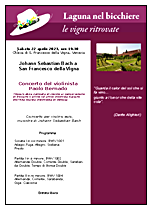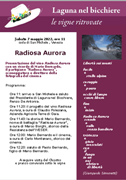Visits to museums, exhibitions, conferences, etc.
“Nicolò Manucci, the Marco Polo of India. A Venetian at the Mughal court in the 17th century”
Wednesday June 14th, 2023
Foundation of the Golden Tree – Palazzo Vendramin Grimani Venice
The guided tour was conducted by our associate and scientific advisor Piero Falchetta.
The exhibition is dedicated to Nicolò Manucci, an illustrious traveler of the 17th century, born in Venice in 1638 and died in Pondichéry around 1720.
In a brief introduction, Falchetta explained to us what the topic of the exhibition is about: an illustration of Nicolò’s life and works, accompanied by various objects reminding the mood of the places where he lived.
In the video of the first room, an actor in oriental clothes describes in broad terms the path taken by Nicolò who left Venice in 1653 and his arrival in the Mughal Empire.
Nicolò was the son of an apothecary. He illegally stowed aboard a tartan on the way to Smyrna, where he met an English nobleman, Henry Bard, viscount of Bellomont who was heading to Isfahan, on a diplomatic mission on behalf of the King of England Charles II Stuart. Nicolò entered Bellomont’s service, and at an initial stop in Smyrna, the journey continued by land to Isfahan, where Lord Bellomont tried to obtain an audience with the emperor. Unfortunately the negotiations aimed at obtaining help for the king are unsuccessful. They then continue their journey to Surat, the largest port in the East Indies.
Henry Bard died shortly after arriving in India in 1656 and Nicolò, left alone, was forced to invent various jobs to survive. When he arrived in Delhi he presented himself at the court of the Mughal emperor’s firstborn, Prince Dārā Shikōh, who offered him a position in the army as an artilleryman.
Involved in the dynastic clashes for the succession to the emperor and after many adventures and wars, Manucci moved to Lahore around 1670 and began to practice the profession of physician.
He later dedicated himself to trading, but after having accumulated a moderate fortune, he lost everything following the sinking of the ship in which his capital was invested.
He was therefore forced to return to Delhi where he was hired as a doctor at the Mughal court.
Around the years 1683-8 he moved to Goa, and decided not to return to Europe. Some close friends advised him to marry an English widow; with her Nicolò led a quiet life, continuing to practice as a doctor. In Goa he had the idea of writing his memoirs, dictated to some mainly Portuguese-speaking scribes. After the death of his wife, in 1706, Manucci moved to Pondichéry, where he died in a place called Monte Grande, around 1720.
The history of memories and their arrival in Europe is very complex and has been the subject of study by numerous specialists.
Piero Flachetta’s video explains in detail the whole manuscripts and the first printed editions. The exhibition is focussed on Nicolò Manucci’s entire legacy, thanks to the cooperation of the Bibliothèque Nationale de France in Paris, the Staatsbibliothek in Berlin and the Biblioteca Nazionale Marciana in Venice.
Manuscripts feature a series of miniatures, known as the Red Book and the Black Book. The former text describes the main characters of Nicolò’s life abroad, the Mughal court, their habits and customs. The latter deals with the social, civil and religious life of the Hindus, completely different from the Islamism professed by the Mughals. These illuminated pictures still amaze and fascinate us with bright colors, unusual shapes, the wonderful rendering of faces and expressions.
The exhibition is enriched with carpets, weapons, paintings and art works from different areas, which remind us of the places where Manucci spent his real adventurous life.
_____
Musical concert by Paolo Bernardo
Saturday 22nd April
Church of S. Francesco della Vigna, Venice

On Saturday 22 April 2023, at the church of S. Francesco della Vigna, Maestro Paolo Bernardo, violin teacher at the Bolzano conservatory and first and only Italian violinist of the Odessa High Violin School, performed Bach sonatas for solo violin.
The concert was dedicated to “Laguna nel bicchiere” by the artist, as the previous year the association had presented the “Radiosa Aurora” wine from the Polesana farm on the occasion of the day dedicated to his father.
“Radiant Aurora” was Mario’s nickname, Paolo Bernardo’s partisan father.
The concert program was as follows:
- Sonata I in G minor, BWV 1001
Adagio; Fuga, Allegro; Sicilian; Soon - Partita I in B minor, BWV 1002
Allemanda-Double; Current-Double; Sarabande-Double; Boreas-Double Time - Partita II in D minor, BWV 1004
Allemande; Current; Sarabande; Jig; Chaconne.
_____
“La Corte delle Impiraresse”
Friday, February 24th 2023
Museum, laboratory-shop of Luisa Conventi
Cannaregio n.100, Venice
On Friday, February 24th, the members of “Laguna nel bicchiere” visited the museum “La corte delle impiraresse” (bead stringers), organized by the artisan Luisa Conventi.
Luisa showed us with competence and enthusiasm all the laborious phases of bead making, cut from cylinders of glass paste, the so-called “conterie”.
We were able to see the various shapes and sizes of tiny beads traditionally used by the “impiraresse”, and discover their charming and evocative names: “balottini, incamisà, papagà, macà, tosca”…
On beholders’ requests, Luisa also described the basic techniques for “rosette” and lampwork beads, the history of Murano bead factories, a detailed illustration of the hand work and the female artisans’ social demands.
Returning to the present, we admired original necklaces and ornaments specifically meant for the many “Impiraresse” Festivals organized from 2009 onwards.
Finally, a short video informed us on the manual skills required, among which the use of loom for the glass fringes.
We were given an extensive overview of a decaying handicraft, today kept alive by a few passionate craftsmen.
See below some photos of the tour.
_____
A novelist from Ravenna to Venice,
Olindo Guerrini’s “Ciàcole de Bepi”
January, Tuesday 25th
Monumental Hall of the Marciana National Library
Guided tour by Dr. Elisabetta Sciarra with readings by our partner Maurizio Vittoria, who translated the “Ciàcole” into Italian.
The guided tour was an opportunity to discover the author Olindo Guerrini, a versatile intellectual, poet and multi-dialect novelist with a unique playful attitude.
Le “Ciàcole de Bepi” are satirical poems in Venetian dialect where Bepi is Pope Pius X, described as a naive country priest in an easy-going and pungent way, intent on chattering about the issues of his time.
The visit continued in the museum section of the Ridotti dei Procuratori di San Marco where the recently restored cartographic works are exhibited: the view of Venice by Jacopo de’ Barbari, the heart-shaped globe by Hajji Ahmaed, presented alongside his wooden plates, the Chinese globe of the Flemish Ferdinand Verbiest and the world globe of Fra’ Mauro.
The visit ended on the first floor of the Mint that displays the ancient coffers of the Republic in fossil wood covered with iron with studs.
_____
2022
Dante in the vineyard
Sunday, October 30th
San Michele vineyard
Professor Giorgio Battistella recited wine, vineyards, and Venice-related verses from the Divine Comedy.
Available attachments:
_____
Residential high voltage
Monday, August 29th
Rialto Fish Pavilion
High voltage housing is a non-profit association focused on the revitalization of Venitian residential life. On August 29th a collective dinner was held at the Rialto Fish Pavilion, one of the areas most affected by the tourist phenomenon, to support the national bill drafted by the association.
During the evening people attended the screening of some unpublished scenes from the film “Welcome in Venice”, introduced by the movie director Andrea Segre. Laguna nel bicchiere joined the following vivid debate.
_____
“Disnar for History”
Friday August 26th
On Friday, August 26th, 2022, Laguna nel bicchiere Association joined the dinner party “Disnar for history”, an event organized by the local Rowing Clubs and other city associations.
The event’s purpose is to invite residents to “go back to the Grand Canal and watch the Historical Regatta from the boats”. For this purpose, free dinner parties are organized in other districts throughout the city.
This year, we shared our food and wines with the friends of the “Sette mari” rowing club at their headquarters in Rio Terà Barba frutariol (Cannaregio).
_____
Radiosa aurora (Radiant Aurora)
 Saturday, May 7th
Saturday, May 7th
San Michele vineyard
Presentation of Radiosa Aurora wine in memory of screenwriter and director of photography Mario Bernardo, known as the partisan “Radiosa Aurora”.
Radiant Aurora (Burning Daylight) is the title of a Jack London novel published in 1902. It was chosen as a battle name by Mario Bernardo, partisan commander of the “Antonio Gramsci” Garibaldi Brigade operating in the Belluno area of Feltre.
After the war, Bernardo worked in the movie industry as a screenwriter and director of photography for some of the most significant Italian movies. He also gave classes in film direction.
The owner of the Terre di Gaia Farm, Claudio Polesana, was pleased to name “Laguna nel bicchiere” organic wine “Radiosa Aurora” in honor of Bernardo. The 2022 bottles were presented on May 7th at St. Michele vineyard by Marco Borghi, President of the Municipality of Venice on the island, a scholar of the history of the Resistance, and a member of the scientific committee of IVESER.
Mr. Borghi told about Bernardo’s life as a partisan during the war, while Carlo Montanaro talked about him as a filmmaker. Montanaro is renowned as a curator of the homonymous archive of material and a former professor of theory and technique of cinematic language.
The presentation was also attended by Bernardo’s son Paolo, violinist and holder of the violin chair at the Bolzano Conservatory.
Mario Bernardo passed away on February 10, 2019, a few days before his 100th birthday.
The video of the meeting is available on our video page; due to its length, it was divided into four parts.
_____
Visit to San Francesco della Vigna
Friday 22 and Saturday 23 April
Guided tour of the Church, the convent complex, the Library and the vineyard of San Francesco della Vigna.
On April 23, the visit began with a historic description of the church by Renzo De Antonia and the next day by Marica Michieli.
Later, Friar Rino Sgarbossa took us with enthusiasm and lightness through to the monastic original library now open to scholars. He illustrated its history, its evolution in the past and future.
An educational itinerary, set up in an internal room, traces the history of the origin of the book: from the manuscript to the printed text. We were shown various binding tools and examples of movable type.
Moreover, the monastery owns the most modern technologies such as the digitization of nautical, geographical and pilot book works.
We then went into the hall of manuscripts and ancient works where unique illuminated chorales are on display, together with antique volumes once preserved in the library of San Michele in Isola.
Finally we enjoyed the view overlooking the Lagoon and the marvel of the vineyard-garden, now managed by a private company, where herbs and flowers together give off a delicious smell of honey.
We ended our experience with a taste of the wines produced by “Laguna nel bicchiere”, with the hope of visiting this magical and secluded place again soon.
_____
“Never seen in Venice”
Friday, March 25th
Never seen in Venice: a stroll
to discover special locations in Venice,
curated by Maurizio Vittoria
_____
“Venice 1600. Births and rebirths”
January 23rd and February 3rd
Venice, Doge’s Palace
Guided tour conducted by Donatella Gibbin.
_____


